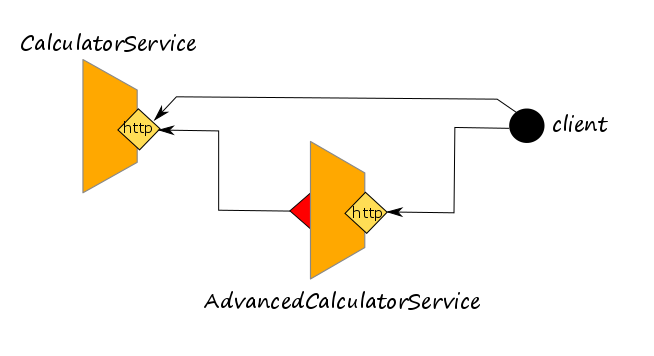Using more than one dependency
In this tutorial we specialize the system of services presented in tutorial Using Dependencies.
In particular, here we suppose to add an advertise message to each call of the AdvancedCalculatorService. The message is retrieved by invoking an external service not implemented in Jolie but exposed using REST.

In the architecture, the AdvancedCalculatorService has one dependency more, from which it can get the advertise messages.
In order to simulate the advertise message provider, here we exploit a funny service which returns Chuck Norris jokes.
The new interface of the AdvancedCalculatorService
In the following, we report the new interface of the AdvancedCalculatorService that we modified in order to deal with the advertise messages.
type FactorialRequest: void {
term: int
}
type FactorialResponse: void {
factorial: long
advertisement: string
}
type AverageRequest: void {
term*: int
}
type AverageResponse: void {
average: double
advertisement: string
}
type PercentageRequest: void {
term: double
percentage: double
}
type PercentageResponse: double {
advertisement: string
}
interface AdvancedCalculatorInterface {
RequestResponse:
factorial( FactorialRequest )( FactorialResponse ),
average( AverageRequest )( AverageResponse ),
percentage( PercentageRequest )( PercentageResponse )
}
It is worth noting that all the response messages, now contain a new field called advertisement that is a string. Thus we expect to receive a new advertise message for each operation call.
The behaviour of the AdvancedCalculatorService
In the following we report the definition of the AdvancedCalculatorService.
from .AdvancedCalculatorServiceInterfaceModule import AdvancedCalculatorInterface
from .CalculatorInterfaceModule import CalculatorInterface
interface ChuckNorrisIface {
RequestResponse: random( undefined )( undefined )
}
service AdvancedCalculatorService {
execution: concurrent
outputPort Calculator {
location: "socket://localhost:8000"
protocol: http { format = "json" }
interfaces: CalculatorInterface
}
outputPort Chuck {
location: "socket://api.chucknorris.io:443/"
protocol: https {
.osc.random.method = "get";
.osc.random.alias = "jokes/random"
}
interfaces: ChuckNorrisIface
}
inputPort AdvancedCalculatorPort {
location: "socket://localhost:8001"
protocol: http { format = "json" }
interfaces: AdvancedCalculatorInterface
}
main {
[ factorial( request )( response ) {
for( i = request.term, i > 0, i-- ) {
req_mul.factor[ #req_mul.factor ] = i
}
mul@Calculator( req_mul )( response.factorial )
random@Chuck()( chuck_res )
response.advertisement = chuck_res.value
}]
[ average( request )( response ) {
{
sum@Calculator( request )( sum_res )
div@Calculator( { dividend = double( sum_res ), divisor = double( #request.term ) })( response.average )
}
|
{
random@Chuck()( chuck_res )
response.advertisement = chuck_res.value
}
}]
[ percentage( request )( response ) {
{
div@Calculator( { dividend = request.term, divisor = 100.0 })( div_res )
mul@Calculator( { factor[0] = div_res, factor[1] = request.percentage })( response_mul )
response = response_mul
}
|
{
random@Chuck()( chuck_res )
response.advertisement = chuck_res.value
}
}]
}
Note that:
- there are two outputPorts definitions. The former one points to the
CalculatorServiceas we described in the tutorial Getting Started, whereas the latter one points to the servicechucknorris.iowe use for simulating the advertisement service; - the outputPort
Chuckuses protocolhttps. The location issocket://api.chucknorris.io:443/where the port is the https standard one:443; - the outputPort
Chuckdeclares an interacted with only one operation:random. No types are defined. - the HTTPS protocol has two parameters:
osc.random.methodandosc.random.alias. The former one specifies to use HTTP method GET when operationrandomis invoked; the latter one specifies how to build the url when operationrandomis invoked. In particular, when operationrandomis invoked, the final URL is obtained as the concatenation of the location with the specified alias(api.chucknorris.io:443/jokes/random). alias has been introduced in protocolshttpandhttpsfor mapping service operations with the actual target urls; - in the behaviour of operation
factorialthe operationrandom@Chuckis executed aftermul@Calculator, this means that the request message torandom@Chuckis sent only after receiving the response frommul@Calculator; - in the behaviors of operations
averageandpercentage,random@Chuckis executed in parallel with those directed to serviceCalculator. Parallelism is expressed using operator|. A parallel composition is finished when all the parallel branches are finished. In operationfactorialparallelism can be used too, sequential composition has been used just for illustrating a different way for composing statements; - in the behaviour of operation
average, the response message can be concurrently prepared in the two parallel branches because the assignments involve two different subnodes of variableresponse:response.averageandresponse.advertisement. The parallel assignments on two separate subnodes of the same variable does not trigger any conflict; - in the behaviour of operation
percentage, variableresponseis not directly assigned in the response message ofmul@Calculator( as it happen writingmul@Calculator( { factor[0] = div_res, factor[1] = request.percentage })( response )). It is because a solicit-response always erases the variable used for storing the received reply. So, if the response tomul@Calculatorwas received after the execution ofresponse.advertisement = chuck_res.valuein the parallel branch, the content of nodeadvertisementwould be erased. Using placeholderresponse_muland then making the assignmentresponse = response_mulallows us to just valorize the root value of variableresponsepreserving the contents of the subnodes.
Running the example
In order to run the example, we need to launch both CalculatorService and AdvancedCalculatorService. Thus, we need to open two shells and run the following commands, one for each shell:
jolie CalculatorService.oljolie AdvancedCalculatorService.ol
In a third shell, try to run the following clients:
curl 'http://localhost:8001/factorial?term=5'curl 'http://localhost:8001/average?term=1&term=2&term=3'curl 'http://localhost:8001/percentage?term=50&percentage=10'
The complete example
The complete example can be found at this link